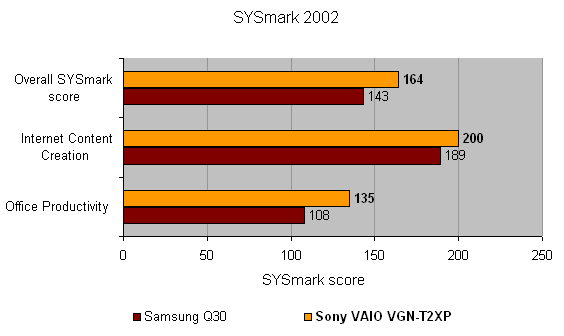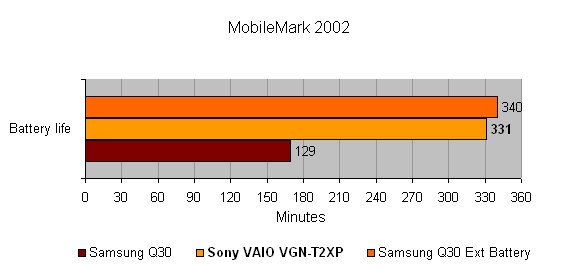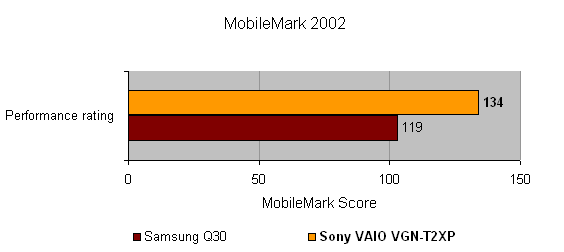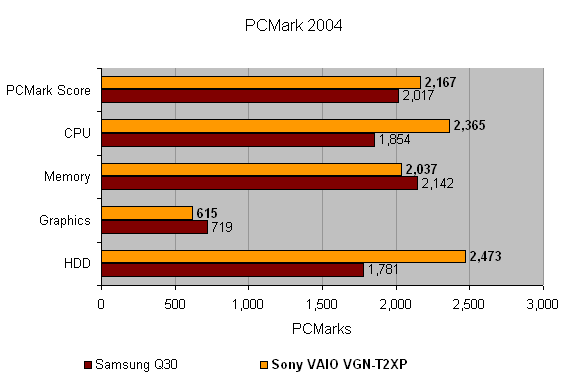Sony VAIO VGN-T2XP Review
Sony VAIO VGN-T2XP
If you want a slim and light notebook with an integrated DVD writer, you should be looking at the VAIO T2XP.

Verdict
Key Specifications
- Review Price: £1522.00
An ultra-portable notebook is a wonderful thing, especially for someone in my line of work. When you’re regularly traversing the globe, covering technology expos and manufacturer launches, you need to have a notebook with you in order to write up your stories. But you don’t want something big and heavy weighing you down, especially on those long days wandering around the crowded halls of a trade show. I’m therefore always pleased to see a new slim and sexy notebook appear on my desk, especially when it’s just in time for a foreign jaunt.
It was by fortuitous chance that Sony delivered its new VAIO VGN-T2XP just a few days before I had to jet off to Taipei to cover Computex. For me, there’s no better way to test an ultra-portable notebook than to take it out in the field. Carrying it around for a few days and knocking out thousands of words of copy gives you a real feel for what the customer will be experiencing – after all, the target customer for a product like this is me.
Now, anyone who reads my notebook reviews regularly will know that my favourite machine for duties like this is the IBM ThinkPad X40, but I have to say that after using Sony’s new baby for a few days, my affection is starting to shift somewhat. You see, the T2XP really is a fantastic solution for the business traveller, but it has also got all those consumer focussed features that Sony loves to throw in.
Let’s start with the most obvious factors first – the VAIO VGN-T2XP is small, very small. Not quite as svelte and light as the Samsung Q30, but it does pack far more of a punch than its Korean competitor. Don’t get me wrong, I love the Q30, but in the end the lack of a PC Card slot made it an unsuitable proposition for me, since I wouldn’t be able to use my Vodafone 3G data card. But not only does the T2XP have a PC Card slot, it also has an integrated DVD writer!
But let’s not get ahead of ourselves. As with all notebooks, there are three factors that I consider to be paramount to an acceptable working environment – a good screen, keyboard and pointing device. Looking at the screen first, there’s no doubt that Sony has pushed the boat out. The 10.6in widescreen display is a superb example, and the Xblack coating makes it ideal for watching movies while you’re on the move. The resolution of 1,280 x 768 gives you far more desktop real estate than most non-widescreen ultra-portable notebooks, which usually sport 1,024 x 768 native resolution. The image produced is bright and the colours vibrant, while the increased reflectivity from the Xblack coating didn’t seem to cause me any problems no matter what lighting environment I used the T2XP in.
Next up is the keyboard, and there have obviously been compromises here because of the reduced physical dimensions of the chassis. OK, so this little VAIO isn’t ever going to have a keyboard as good as a ThinkPad X40, but it is nonetheless very impressive. Obviously the key size is reduced, so you may want to try one out before you buy if you have large hands. I had no problem typing at speed on the T2XP, but then I do have pretty small hands. That said, what really impressed me was that Sony has kept pretty good continuity with the relative key sizes, compared to a regular keyboard. The Shift, Caps, Tab, Return, and Backspace keys are all large, and the Ctrl key is located at the bottom left, just where it’s meant to be.
The final part of the ergonomic equation is the touchpad, and Sony certainly hasn’t skimped here. The silver touchpad is located far enough from the Spacebar to avoid any inadvertent cursor movement, so you don’t have to worry about erasing large blocks of text when you’re typing at speed. Below the touchpad are two silver buttons, which obviously reflect the left and right buttons on a mouse. Also, the far right side of the touchpad can be used to scroll up and down through a document, although there’s no indication of this feature. Despite the fact that I prefer trackpoints to touchpads, this one is a fine example and pointer manipulation is quick and accurate.
Inside the T2XP, the specs are pretty impressive considering the size of the notebook. Driving things along is an Ultra Low Voltage Pentium M CPU running at 1.2GHz – no doubt the choice of a ULV chip has helped the Sony achieve very impressive battery life. There’s 512MB of memory installed, but 8MB has been dedicated to the integrated Intel 855GME graphics chipset. You could allocate up to 64MB to the graphics chipset, but it really isn’t worth it – you’re better off keeping the memory accessible by your applications.
Storage comes courtesy of a 60GB hard disk, which is a fair amount considering the size of the unit. If however you do want to free up some space on your hard drive, you can easily offload data via the integrated DVD writer, which will burn to both DVD-R/RW and DVD+R/RW media.
Connectivity is very well catered for, with a 56k modem and a 10/100 Ethernet adapter. But if you don’t want to be tethered to a phone line or network port, there’s also an 802.11b/g wireless adapter as well as integrated Bluetooth. Obviously the former makes up part of the Centrino branding, but it’s always good to see Bluetooth, for those instances where you can’t find a hotspot and need to connect via your mobile phone.
The right hand side of the chassis is dominated by the DVD writer, but the modem socket and Ethernet port are also located here, behind sturdy plastic flaps. At the front you’ll find volume controls and a mute button, along with headphone and mic sockets. There’s also a hard switch for the WiFi and Bluetooth adapters.
At the left there’s a single Type II PC Card slot, a Memory Stick/Memory Stick Pro slot, two USB 2.0 ports, a four-pin FireWire port and a D-SUB port. Last but not least, above the keyboard and below the screen you’ll find an array of indicator lights, the power button, and a set of multimedia controls. Pressing the DVD button will bring up Sony’s own multimedia app, from where you can play music, look at photos or watch a DVD.
At the rear the you’ll see that the battery protrudes slightly, but not enough to spoil the overall look of the machine. Personally I’m happy to have a slightly larger battery if the result is improved battery life, and that’s certainly the case here. Running Mobile Mark 2002, the T2XP exhibited a battery life of over five and a half hours. That makes this machine very attractive to the road warrior who wants something small, light and usable on the move.
The SYSmark score of 164 overall is pretty decent, and puts similar notebooks like the JVC Mini Note in the shade. But it’s in real world use that a machine like this stands or falls, and I have to say that the T2XP performed superbly in the field. When I took this little machine with me to Computex in Taiwan, it proved to have the perfect blend of light weight, long battery life and features. Also, when I’m working on the move I tend to have multiple applications open concurrently such as Word, Photoshop, Excel and loads of web browser windows, and I’m glad to say that the T2XP coped brilliantly.
Considering that you’re getting an integrated DVD writer, the weight of 1.38kg is very commendable, while the dimensions of 275 x 205 x 25-34mm (WxDxH) mean that you can slip the T2XP into the smallest of bags. I also like the fact that there is no securing catch on this machine – the hinge is just sprung towards the closed position, making it easy to open the notebook quickly.
It’s also worth mentioning that Sony always throws together a great software bundle for its notebooks. As well as Windows XP Professional, you get a copy of Microsoft Works 8, Adobe Premier Standard, Adobe Photoshop Elements 2.0, Adobe Photoshop Album 2.0 Starter Edition, Adobe Acrobat Elements, WinDVD and Symantec Internet Security 2005 (with 90 days of updates). Sony also throws in a bunch of its own software like SonicStage, PictureGear Studio and VAIO Zone – which is the default multimedia playback application.
Of course the T2XP doesn’t come cheap, but then that’s to be expected with a machine as slim and sexy as this. That said, a price of just over £1,500 is pretty much average for an ultra-portable machine from a big player like Sony. Personally I think that the T2XP is worth every penny, and would be happy to use one as my travelling companion whenever I find myself jetting off.
”’Verdict”’
The Sony VAIO VGN-T2XP is a fantastic little notebook. It has pretty much everything you need integrated into its svelte chassis, but still manages to keep weight down to a minimum. The outstanding battery life just makes this machine even more attractive to the target market. If you want something small and light with great battery life and an integrated DVD writer, the T2XP should be top of your list.
(table:features)




How we test laptops
Unlike other sites, we test every laptop we review thoroughly over an extended period of time. We use industry standard tests to compare features properly. We’ll always tell you what we find. We never, ever, accept money to review a product.
Trusted Score
Score in detail
-
Performance 8
-
Value 8
-
Features 10

